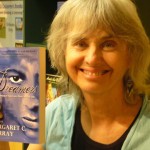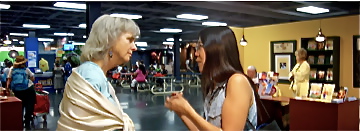
The most popular question I was asked at the California State Fair Author’s Booth two weeks ago was, “Is this story true?” The person before me would often be holding a copy of my novel, Dreamers, A Coming of Age Love Story of the ‘60s that they had just picked up from the display. On the cover is a close-up of an intense, attractive African-American male and a lovely, smiling Caucasian female.
Also displayed on the table is my first novel, Sundagger.net, a story of one family, two worlds, and many lifetimes. But no one seems to ask if Sundagger.net is true. It is only Dreamers that prompts this question.
I felt put on the spot. Did I hear an assumption that a book is better if the author says it’s true? Is non-fiction better, more serious, more worthy of attention than fiction? With the exception of writers who specialize in niches like thrillers or children’s books. the best sellers at the CA State Fair Authors Booth appeared to me to be the writers of non-fiction. After all, readers were excited by the accounts of authors who stood right in front of them speaking to the truth of the tale.
Is Dreamers fiction or non-fiction? More aptly, did it really happen to me? You might think that given the frequency with which I was asked, I would have a short (or long) definitive reply that resolves the issue. But the truth (!) is, I anguished over my replies and each answer I gave was different.
It’s not an untenable question to ask. Anyone can infer looking at me that I was coming of age too in the ’60s like Annie Ryan, the young white woman in Dreamers who falls in love with the black actor, Thomas. And then, flipping through the book, you can see that Dreamers is full of many well-known facts of the era, for example the Birmingham bombings, Watts riot, Martin Luther King, Jr’s, “I have a dream” speech and Johnson’s landmark civil rights legislation. But the question carries a special importance to the person asking. I can feel that their urgency. It’s not a light matter.
Sometimes I said jokingly, “It’s all lies. ” Sometimes I threw caution to the wind and struggled to explain what I meant.
I mentioned whole scenes in Dreamers that I remembered as true. Not only did they happen to my character, Annie; they also happened to me. One such scene is where Annie goes to Midnight Mass alone and reflects on the beauty of the traditional Catholic Christmas ritual, holding her nostalgia for the faith of her family and her youth like an old, precious doll. This happened to me–not the doll part– but the nostalgia and sense of loss. But then (I have to confess) I gave the church in Dreamers a different name from the one I was really in that Christmas eve back in the sixties. Why? I wanted a bigger truth than fact. I wanted the truth of fiction.
I could have marked whole paragraphs of Dreamers with colored markers; pick one color for truth, another for fiction. Each page would be checkered in both colors! The same with each sentence, even phrases.
It started in high school when I determined to be a fiction writer rather than a journalist, taking Hemingway as my example, because the prospect of being accountable for the truth of any set of facts, any situation, seemed just too big and impossible to take on. This book was years in the making; finally I began to trust my own inner eye, looking for the other, better story than whatever I remembered had really happened, a story that came through fiction like a phoenix rising from the ashes. In short, I lied as much as I could.
It was easier to talk about the truth of the times in Dreamers. I had one great conversation with a man from Youngstown, Ohio, right down the river from Pittsburgh where I was born and grew up and where much of Dreamers takes place. We both were excited by the similarities between those two steel-driven cities, now dinosaurs of the coal industry. That led to good talk about gentrification and the destruction of the inner city.
At the fair I had many people tell me that it could be their story or their mother’s, an aunt or their best friend’s, even the mother of a best friend. One woman asked me if I had had the baby, referring to the obvious outcome of Annie and Thomas’ romance being the birth of a multi-racial child. This led to an intense conversation about the dilemma of being multi-racial in America today (as if we all aren’t in fact relatives, descended from that one dark couple in Africa eons ago.)
had the baby, referring to the obvious outcome of Annie and Thomas’ romance being the birth of a multi-racial child. This led to an intense conversation about the dilemma of being multi-racial in America today (as if we all aren’t in fact relatives, descended from that one dark couple in Africa eons ago.)
I was amazed by the deep emotions I saw on all their faces. Humbled too. Along with nostalgia and a pervading sadness at loss, I sensed fear–not of the story, not the romance, but a fear of hope hovering over the book. “After all, I’ve worked hard to put all that behind me,” I imagined them saying. There was a sense that the story wasn’t finished, that somehow it shouldn’t be over. One person asked when I would write the sequel. As it was, it took me too long to write Dreamers I replied.How many more lies I’d have to conjure up! We both laughed at that and for just a moment I thought, Yes! I found the right answer. The answer to “Is it true?” is “I hope so.”
